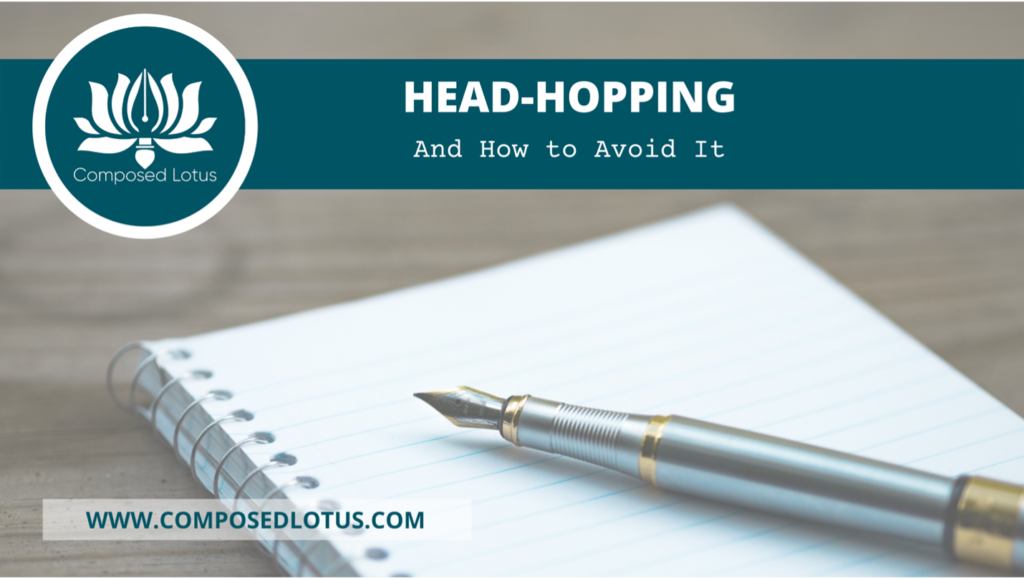
What you’ll learn:
- What is a viewpoint character?
- What is head-hopping?
- How can you fix head-hopping?
Have you been told by an editor or your beta readers that you are ‘head-hopping’? Has your editor indicated that you need better “transitions between points of view”?
If so, we’ll help you on your way to a head-hopping-free manuscript!
The viewpoint character is from whose lens the story is being told or through whose eyes we are watching the story unfold.
If your scene or chapter is written in first person, the viewpoint character is easy to spot: It’s the “I” character.
If you’re telling your story in third person (Jane/John, they, he/she/them), it can get a bit messier.
When writing from a viewpoint character, you are portraying the scene through that character’s five senses: what they can see, taste, smell, touch, or hear. You can also get into their thoughts and how they respond or react to things. Viewpoint characters have their own personality; they speak certain ways or use certain words. The viewpoint character can see or hear other characters.
Jane hesitated slightly before pushing open the boardroom door. All eyes were on her. She could feel her heart begin to race and the all-too-familiar flush of her cheeks. Surely John was too professional to tell anyone. These were his buddies, she knew. She took a deep breath and mustered up all the confidence she could. “Good morning, gentlemen.”
We cued the reader that Jane is the viewpoint character. She touched the door. She can see everyone looking at her. She can feel her own nervous reaction. She knows the secret she’s trying to keep. As a reader, you can relate to her anxiousness.
Head-hopping happens when you unintentionally have more than one viewpoint character’s perspective in one sentence, paragraph, or scene. (It can also refer to switching between first person and third person point of view.)
Jane hesitated slightly before pushing open the boardroom door. All eyes were on her. She could feel her heart begin to race and the all-too-familiar flush of her cheeks. Surely John was too professional to tell anyone. These were his buddies, she knew.
John thought he heard her sigh as she walked through the room. She was probably thinking about the amazing night they’d just spent together.
She took a deep breath and mustered up all the confidence she could. “Good morning, gentlemen.”
Head-hopping confuses your reader. In the passage above, we were initially drawn into what Jane was experiencing in the first paragraph. In the second paragraph, we experienced an abrupt switch to John as the viewpoint character. Jane wouldn’t know what John could hear or what he was thinking. We pop back into Jane’s head again in the third paragraph. As the writer, you’re now going to have to work harder to get the reader re-engaged with Jane’s character. If you do this too many times, you could lose your reader entirely. Head-hopping is one of the biggest ‘tells’ of an inexperienced writer.
Head-hopping is typically addressed during a developmental edit. However, this is a step many authors skip. Copyeditors don’t always mention head-hopping or provide you with solutions. They are typically more focused on grammar, punctuation, and spelling. If head-hopping issues are apparent in a sample edit, your quote for copyediting might be higher than you anticipated.
Tips to Fix Head-Hopping
Head-hopping is easy to fix once you understand the basics.
- Unless you are an uber-experienced writer, it is easiest to keep to one viewpoint character per chapter. You can cue your readers about viewpoint character changes between scenes, but don’t change viewpoint characters within paragraphs!
- Identify who the viewpoint character is in each chapter, scene, and paragraph. You could unintentionally be giving headspace to the wrong character. It happens.
- Read through your paragraphs, scenes, and chapters to see whose eyes you’re telling the story through. Ask yourself: Would that viewpoint character be able to see, touch, hear, smell, or touch whatever I’m talking about?
- Consider whether you really need to have multiple viewpoint characters in a scene or chapter. Can you tell the story through a single character’s lens?
- If you need to use more than one viewpoint character within a chapter, do it in a new scene, and be sure to cue your reader with some type of transition. You can use the new viewpoint character’s name or use typography markers such as an added line break or dinkus (***).
